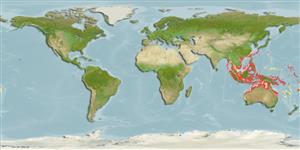Common names from other countries
Environment: milieu / climate zone / depth range / distribution range
Ecologia
marino; salmastro associati a barriera corallina; oceanodromo (Ref. 51243); distribuzione batimetrica 0 - 42 m (Ref. 95469). Tropical; 30°N - 30°S, 92°E - 16°W
Eastern Indian Ocean to Western Pacific: from Andaman Islands to E Australia and to Japan and New Caledonia.
Length at first maturity / Size / Peso / Age
Maturity: Lm 11.0, range 10 - ? cm
Max length : 30.0 cm TL maschio/sesso non determinato; (Ref. 121202)
Spine dorsali (totale): 8; Raggi dorsali molli (totale): 9; Spine anali 1; Raggi anali molli: 6. This species is distinguished by the following characters: D VIII + 9; pectoral fins 12-14; gill rakers 4-7 + 15-19 = 20-25; lateral line scales 28-31; the following measurements are in %SL- body depth at first dorsal fin origin 21-28 and at anus 18-24; caudal-peduncle depth 9.5-12, width 3.1-4.9L; maximum head depth 18-24; head depth through eye 14-20; head length 26-32; postorbital length 9.9–13; orbit length 5.3-8.9; upper jaw length 9.8-14; barbel length 13-21; caudal-peduncle length 22-27, caudal-fin length 29-34; anal-fin height 16-20; pelvic-fin length 19-24; pectoral-fin length 17-22, width 3.5-5.3; first dorsal-fin height 20-25; second dorsal-fin height 17-21; postorbital length 1.4–2.0 times in anal-fin height; all fins with red, brown or black stripes, bars or blotches; 7–19 oblique bars on caudal fin, 3-9 bars on upper lobe, 4-10 on lower lobe; first dorsal fin with a large blotch around tip; one red, brown or black mid-lateral body stripe from tip of snout through eye to caudal base; body and head ground colour white or beige, slightly darker above lateral line, with irregular red, brown or black spots and/or blotches; yellow barbels but may be pale brown or orange in fresh fish; most of body and fin pigmentation retained on preserved fish (Ref. 95469).
Known to enter lower reaches of rivers. Usually found on sandy bottoms in nearshore areas; usually solitary (Ref. 68964). Forms small to moderately large aggregations at all sizes (Ref. 48636). Minimum depth from Ref. 3470.
Life cycle and mating behavior
Maturità | Riproduzione | Deposizione | Uova | Fecundity | Larve
Uiblein, F. and G. Gouws, 2014. A new goatfish species of the genus Upeneus (Mullidae) based on molecular and morphological screening and subsequent taxonomic analysis. Mar. Biol. Res. 10(7):655-681. (Ref. 95469)
IUCN Red List Status (Ref. 130435)
CITES (Ref. 128078)
Not Evaluated
Threat to humans
Harmless
Human uses
Pesca: commerciale; Acquario: Commerciale
Informazioni ulteriori
BibliografiaAcquacolturaProfilo di acquacolturaVarietàGeneticaElectrophoresesEreditarietàMalattieElaborazioneMass conversion
Strumenti
Special reports
Download XML
Fonti Internet
Estimates based on models
Preferred temperature (Ref.
115969): 24.8 - 29.1, mean 28.2 (based on 734 cells).
Phylogenetic diversity index (Ref.
82804): PD
50 = 0.5000 [Uniqueness, from 0.5 = low to 2.0 = high].
Bayesian length-weight: a=0.00933 (0.00757 - 0.01151), b=3.09 (3.06 - 3.12), in cm Total Length, based on LWR estimates for this species (Ref.
93245).
Trophic level (Ref.
69278): 3.6 ±0.0 se; based on diet studies.
Resilienza (Ref.
120179): Alto, tempo minimo di raddoppiamento della popolazione meno di 15 mesi (Preliminary K or Fecundity.).
Fishing Vulnerability (Ref.
59153): Low vulnerability (18 of 100).
